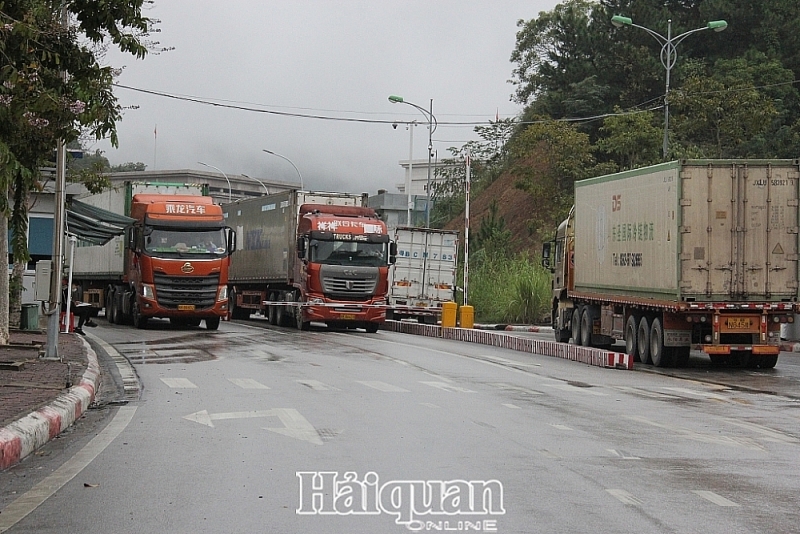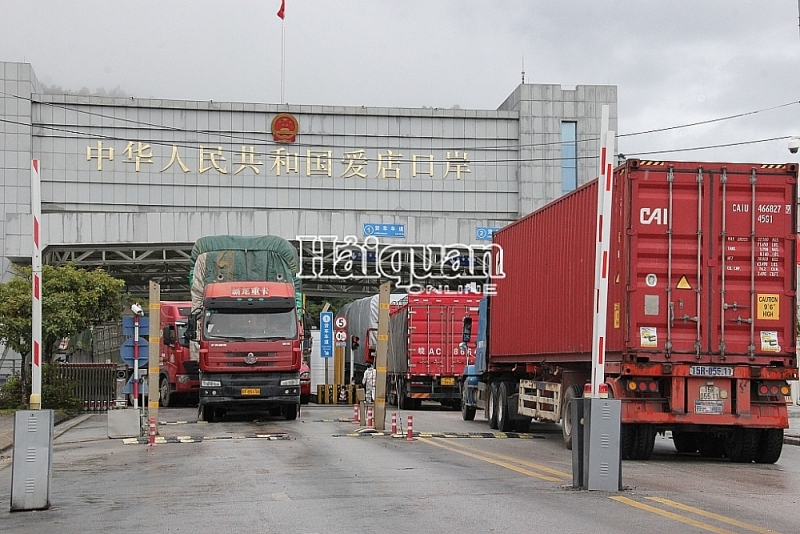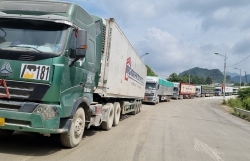In order to ensure import and export activities at border gates after China officially opened the border, during the inspection of pandemic prevention and control during the Lunar New Year on January 9, the Ministry of Health proposed Lang Son province urgently organize the implementation of new regulations on the prevention of the Covid-19 pandemic.
On January 10, the People’s Committee of Lang Son province changed a number of import-export control procedures through border gates in the area such as removing the buffer zone that is the transshipment area of goods at Huu Nghi international border gate (Cao Loc district) and a non-tariff zone at Tan Thanh border gate (Van Lang district).
Accordingly, vehicles carrying export goods can go directly to the area of Huu Nghi international border gate and Tan Thanh border gate for customs clearance and transportation to China. Lang Son province also removed the control of negative test certificates valid for 72 hours for drivers and their companions who must stay in the transshipment area and the non-tariff area.
People entering the border gate area must follow the 2K epidemic prevention plan (mask, disinfect) and only perform a quick test of SARS-CoV-2 for people with symptoms of acute respiratory infection, and patients suspected of having Covid-19.
 |
| Import-export trucks passing through Huu Nghi international border gate were able to go straight through. Photo: H.Nu |
At Huu Nghi international border gate, stopping the regulation and channelization of means of transport of export goods into the transshipment zone. Restoring the traditional method of freight forwarding as before, that is, the driver and the companions across the border of the two sides can control the vehicle carrying goods directly into the yard of the opposite country to deliver and receive the goods.
Before entering China, drivers of vehicles carrying import and export goods and their accompanying passengers need to have negative 48-hour PCR test results for Covid-19 and fill in the test results on the health declaration form required by China Customs.
At Tan Thanh sub-border gate, in the near future, two methods of freight forwarding will be implemented in parallel, that is, the contactless delivery method (using a specialized tractor and a specialized driver of the wharf company) and the traditional method of delivery and receipt of goods as before, the driver and the companions across the border of the two sides can control the vehicle carrying goods directly into the yard of the opposite country to deliver and receive the goods.
Before entering China, drivers of vehicles carrying import and export goods and their companions need to have a negative 48-hour PCR test result; in case the driver and companion cannot deliver the goods within the day but must leave the vehicle on the Chinese side, at the end of the day, the Chinese side will arrange a vehicle to take the driver and companion to the Km0 area (dedicated road for transporting goods for entry procedures). The next day, the Chinese side will arrange a vehicle to pick them up at the above location (the cost of the shuttle will be paid by the driver and companion).
 |
| Customs clearance activities at Chi Ma border gate still take place normally. Photo: H.Nu |
At Chi Ma and Coc Nam border gates, the transportation of import and export goods through the border gate continues according to the method that Chinese drivers drive vehicles across the border to deliver export goods and receive import goods.
According to Mr. Hoang Khanh Duy, Deputy Head of the Management Board of Dong Dang-Lang Son border gate economic zone, after 3 days of implementing import-export activities by new methods, the number of export vehicles has not increased dramatically, even though drivers and their companions can deliver and receive goods in the Chinese yard. The reason is that many drivers are waiting for negative PCR test results, and businesses are doing passport procedures.
However, Mr. Hoang Khanh Duy expects import-export activities will be more bustling and based on reality, continue to exchange and negotiate with the Chinese side to have solutions to facilitate the best goods trade for businesses and people of the two countries.
Lang Son Department of Industry and Trade suggested that the People’s Committees of provinces and cities provide information and recommendations to businesses trading and transporting import and export goods of the locality through Lang Son province to seriously implement the above procedures. At the same time, actively prepare documents according to regulations to facilitate entry and exit, import and export; be proactive in declaring information on the digital border gate platform before entering the border gate area.
Lang Son province also recommends that drivers operating vehicles carrying import and export goods and their companions must wear N95 masks during the delivery and receipt of goods in China.
With the easing of customs clearance activities, many businesses, traders and drivers are happy to be able to carry goods directly across the border into China for delivery instead of having to pay the expense of hiring a specialized driver as before.
 | Lang Son Customs: Efforts to boost customs clearance |
As noted, after implementing a new import-export method to adapt to China’s anti-pandemic conditions, every day, nearly 1,000 trucks of goods are cleared through border gates in Lang Son province.
